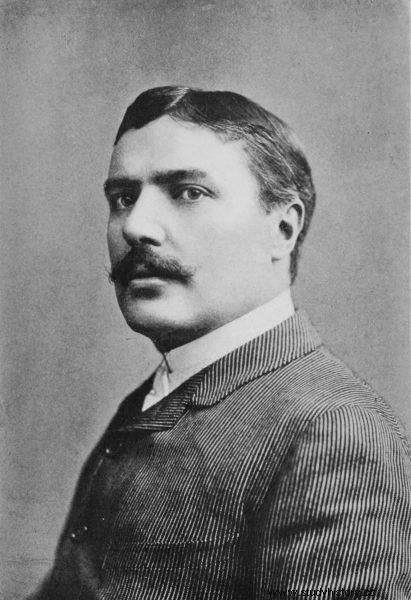The story of the life and death of Charles Francis Coghlan has all that is good in captivating stories - a curse, great passion, even greater scandal and premature death. However, it does not end with the departure of the main character, because perverse fate decided to add something extra to it. Namely, the wandering coffin with his remains.
Charles Francis Coghlan was an Irish-English actor and playwright who enjoyed enormous popularity on both sides of the Atlantic Ocean in the second half of the 19th century. Born in Paris, he was the son of Francis Coghlan, publisher of the famous Coghlan's Guides (Charles Dickens was one of his friends).
Charles - in accordance with the wishes of his parents - was to be educated to become a lawyer, but from an early age he dreamed of an actor's career and this is where he finally turned his steps. Later friends told him that his success in this profession was predicted by a Gypsy woman . However, it was not her only omen for the man. The woman also foresaw his death, which was to take place at the height of his fame, and the subsequent wandering of his soul, ending years later with his return home ...
This event influenced Coghlan quite strongly. As described in her memoirs by actress and producer Lillie Langtry, who worked with Charles and his sister, actress Rose Coghlan, he believed he was cursed. However, this did not prevent him from becoming one of the most famous artists of his time.

Coghlan not only acted in theaters, but also wrote plays and started acting in the first films
His success in Great Britain drew him to the attention of eminent New York theater scene personalities, including John Augustin Daly. It was he who brought Charles to Broadway, where his career gained momentum. Coghlan not only acted in theaters, but also wrote plays and started acting in the first films. Together with his sister, he also founded his own theater and production company.
He took his partner Louisa Thorn and little daughter Gertrude to America. The whole family settled in a residence on Prince Edward Island, which Charles considered as his safe haven. It was here that he came back
after his tour to take a break from the crowds and focus on writing theater plays. Despite minor perturbations, his life seemed to go on a steady track - until 1894, when he appeared on the pages of the New York Times, causing a sensation that shook his career and family relationships.
Mr. Coghlan's morals
Well, a successful actor and a devoted father ... he secretly married the young actress and sculptor Kühne Beveridge. When the news about this event went to the press, a scandal broke out. It emerged that Charles and Louisa were living in an informal relationship and that their daughter was illegitimate (which was considered extremely outrageous at the time).
Coghlan, wishing to save the girl's reputation, announced that she was his adopted child, but it did not help. New York's nineteenth-century society was indignant; Charles's career hangs by a thread . As a result, his sister was forced to break off her business partnership with him, and the marriage that had barely begun was already over. A year after his conclusion, Charles returned to Prince Edward Island, where - surprisingly - Louisa welcomed him with open arms.
Everything was slowly returning to normal. It didn't take long for the actor to shine again on stage, enjoying even greater popularity. Soon, however, fate was about to turn around…
In October 1899, Coghlan traveled with his troupe to a performance in Galveston, Texas. Unfortunately, even before the performance, he fell so seriously ill that he was unable to perform. He lay in bed for a month and struggled with his ailments until on November 27 he passed away forever. But this is where his story does not end.
The Wandering Coffin
After Charles died, there was a problem with pointing to the place of his burial. Both Prince Edward Island and New York's farm were considered. This indecision caused the metal coffin with the actor's remains to be placed in a crypt in Galveston, where she had to wait for the dilemma to be resolved.
Unfortunately, it was unfortunate that in 1900 a powerful hurricane hit the city, later named The Great Galveston Hurricane. The storm was the most powerful that hit the US to date. It destroyed many thousands of buildings and killed from 8,000 to even 12,000 people.

Due to a moral scandal, Charles's career hung in the balance.
The damage at Galveston was beyond description. In addition to the strong wind, the hurricane brought with it a flood that took, among others, into the ocean. coffins from the city cemetery - including the one with Coghlan's body. Thus began her great journey, which was followed with enthusiasm by local and national newspapers.
In 1900, she was sighted outside the city of La Marque, Texas, and in January 1904 she appeared on Galveston Beach. However, it turned out that both discoveries were not related to Charles's remains. There was even a reward for finding the coffin, but no one ever won.
In 1907, in a swamp a short distance from Galveston, a group of hunters would eventually find the right remains, but despite these revelations, its final resting place remained unknown. And unresolved stories always get attention. In 1927, Robert Ripley made Coghlan's floating coffin famous in his "Ripley's Believe It or Not!" Column. In the text, he theorized that it crossed the ocean and was eventually washed ashore on Prince Edward Island, 5,000 miles away. Charles Francis Coghlan was to return home 8 years after his death - just as the prophecy had said.
However poetic the ending would be, it is unfortunately still unknown what really happened to the actor's corpse and whether his soul actually ended its journey at home.
